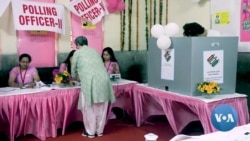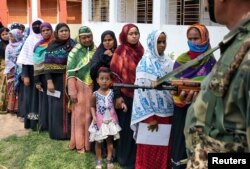They occupy only 25 per cent of the work force, less than 12 per cent of parliamentary seats, a backseat in many homes dominated by patriarchal voices, but in one significant area Indian women have emerged on par with men: at polling booths. That has made political parties sit up and take notice in a country where a slim margin can make the difference between victory and defeat.
To mark women’s empowerment, the Election Commission set up hundreds of “pink booths” in the country during the five-week general election that wraps up Sunday. In the capital, New Delhi, several polling stations were festooned with balloons and staffed with women and volunteers who handed out roses and sweets setting a festive atmosphere.
There may well be reason to celebrate: the hope is that this general election will virtually close the voter gap between men and women, which five decades ago stood at 15 per cent but narrowed down to one and a half per cent five years ago.
“The elimination of the gender gap in turnout would be a monumental achievement, especially in a conservative, patriarchal society like India’s,” says Milan Vaishnav, Director of the South Asia Program at the Carnegie Endowment. “In 2019, nearly all parties are touting their pro-women credentials if for no other reason than they cannot afford to alienate a growing segment of the electorate.”
Prime Minister Narendra Modi, a savvy political strategist, aimed several of his welfare programs at women during his five years in power: his government spearheaded programs to build toilets in village homes, provided cooking gas connections to replace stoves using cow dung or coal, initiated a free healthcare program for the poorest households and doubled maternity leave from three to six months.
The main challenger to Modi’s Bharatiya Janata Party, the opposition Congress Party, has also packed its election manifesto with pro-women initiatives. The biggest lure it is offering: one third reservation for women in new appointments to federal government jobs.
Other promises being made by parties include workplace crèches, measures to strengthen safety for women and even free sanitary napkins.
It is not just the growing numbers of women voters that matter. In a country where men often dictate choices, including political representatives, many are striking out to make independent decisions.
In 2015, it was the promise of a regional leader, Nitish Kumar, to ban alcohol that is widely credited with helping him win reelection in Bihar state – it appealed to women fed up with husbands spending scarce household money on liquor. They turned out in larger numbers than men to vote.
Sociologists say political assertiveness is growing partly due to better levels of education among girls and due to a 1993 law that mandated reservation of key posts in village bodies for women representatives. “Nearly a million women have contested for village council polls. They are now very aware of development and other issues,” according to Bidyut Mohanty at the Indian Institute of Social Sciences.
Preferring to vote on issues such as governance and development, women are being called a “caste neutral constituency” in a country where voting is often done on caste and community lines.
Some women like New Delhi resident Usha Gupta firmly believe that women can make better choices. “Women can run the house. So they know who can run the country in a better way.”
Others like 32-year-old Manisha Ojha stepped out for the first time to vote disturbed by an increasingly polarized atmosphere in the country. “I should choose democracy over dictatorship. That drew me out to vote against some ideologies that I don't believe in.”
The process of getting more women to polling booths picked up about a decade ago, when the Election Commission led a huge campaign to draw out voters. It sent out brand ambassadors to rural areas and enrolled women whose names were missing. Citing the example of India’s largest state, Uttar Pradesh, former chief election commissioner, S.Y Quraishi, says, “dramatic results were observed. A 45 per cent increase in women turnout was recorded in 2012, which is remarkable.”
The steady increase in female voter turnout is hugely significant because women are impacting electoral outcomes, according to Shamika Ravi, Director of Research at Brookings India. “That is why we call them agents of change. Men are voting more for job opportunities, women are voting more for things like access to drinking water.” She calls it a “silent revolution.”
Among those who voted emphatically for change in the ongoing general election is Safedi (one name only) an elderly voter in Haryana state who is demanding the development that often bypasses rural areas. “There are no facilities in my village. I want a good hospital, cleanliness and proper roads. The sewers in my village are overflowing. The last government has not done anything.”
Young, urban women voters are focused on larger issues. “Gender inequality, pay wage gaps, these two things are very important. Also women's security, women's empowerment,” says Saanya Verdia, a 19-year-old college student, who says voting will always be a top priority for her.
However while the percentage of women casting ballots is on par with men, their numbers are lesser because an estimated 20 million women eligible to vote are still missing from electoral rolls. India has 900 million voters.
And while women voters may be making their voice heard at polling stations, it may still be a long haul to get more of them into state legislatures and parliament. Two regional parties in West Bengal and Orissa broke ground this year by putting up nearly 40 per cent of women candidates, but mainstream parties, the BJP and the Congress, have fielded a meager 13 per cent. “Political parties need to create a pipeline of women leaders,” says Ravi.








